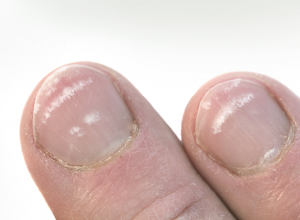
Leukonychia
Leukonychia is the medical term used for white discoloration or small white spots that occur on nails.
Sypmtoms
Leukonychia is usually characterized by painless white spots that appear on the nails. The condition is more common on fingernails than on toenails, but it affects both. The degree of whiteness and discoloration depends on the type of luekonychia present.
Causes
There is debate over what causes common types of leukonychia, with some people arguing that the white spots appear from an excess or deficiency in calcium, zinc and other vitamins. However, most doctors agree that the white discoloration is caused by minor injuries at the base of the nail. As it stands, leukonychia is an idiopathic condition (meaning its origins are unknown).
Leukonychia partialis is when parts of the nail plate develop small white spots or lines. There are three types of this condition:
Leukonychia striata
Leukonychia striata, sometimes called transverse leukonychia, is characterized by a whitening or discoloration of the nail in bands (stria) that run parallel to the nail base. They are most often caused by injuries like slamming your finger in a car door or wearing shoes that irritate or bump against the toenails. However, leukonychia striata can sometimes be caused by heavy metal poisoning, lead, arsenic, cirrhosis or chemotherapy (usuallly called Mees' lines) or other underlying medical conditions (usually called Beau's lines). There is also a type of leukonychia called Muehrcke’s lines, which lis characterized by the discoloration being part of the vascular nail bed rather than the nail plate (meaning the white lines do not grow out with the growth of the nail like with other types of leukonychia).
Leukonychia punctata
Leukonychia punctate, also known as true leukonychia, is the most common type of leukonychia. The small white spots are generally caused by picking or biting of the nails, as well as small bumps and injuries to the nail bed. The white spots usually disappear completely in about eight months.
Longitudinal leukonychia
Longitudinal leukonychia is one of the more rare types of the nail condition and features very small longitudinal white lines. It is often associated with Darier’s disease.
Leukonychia totalis is an entire whitening of the nails and may be a sign of hypoalbuminaemia (low albumin), which can be present in anyone suffering from kidney failure, liver failure, protein malabsorption and protein-losing enteropathies. Leukonychia totalis may also be caused by certain antibiotics and genetic conditions.
Treatment
There is no treatment for leukonychia. However, the white spots usually disappear over time as the nail grows. If leukonychia is caused by other medical conditions, that condition must be treated separately.
Notice concerning medical entries:
Articles having medical content shall serve exclusively for the purpose of general information. Such articles are not suitable for any (self-) diagnosis and treatment of individual illnesses and medical indications. In particular, they cannot substitute for the examination, advice, or treatment by a licensed physician or pharmacist. No replies to any individual questions shall be effected through the articles.







